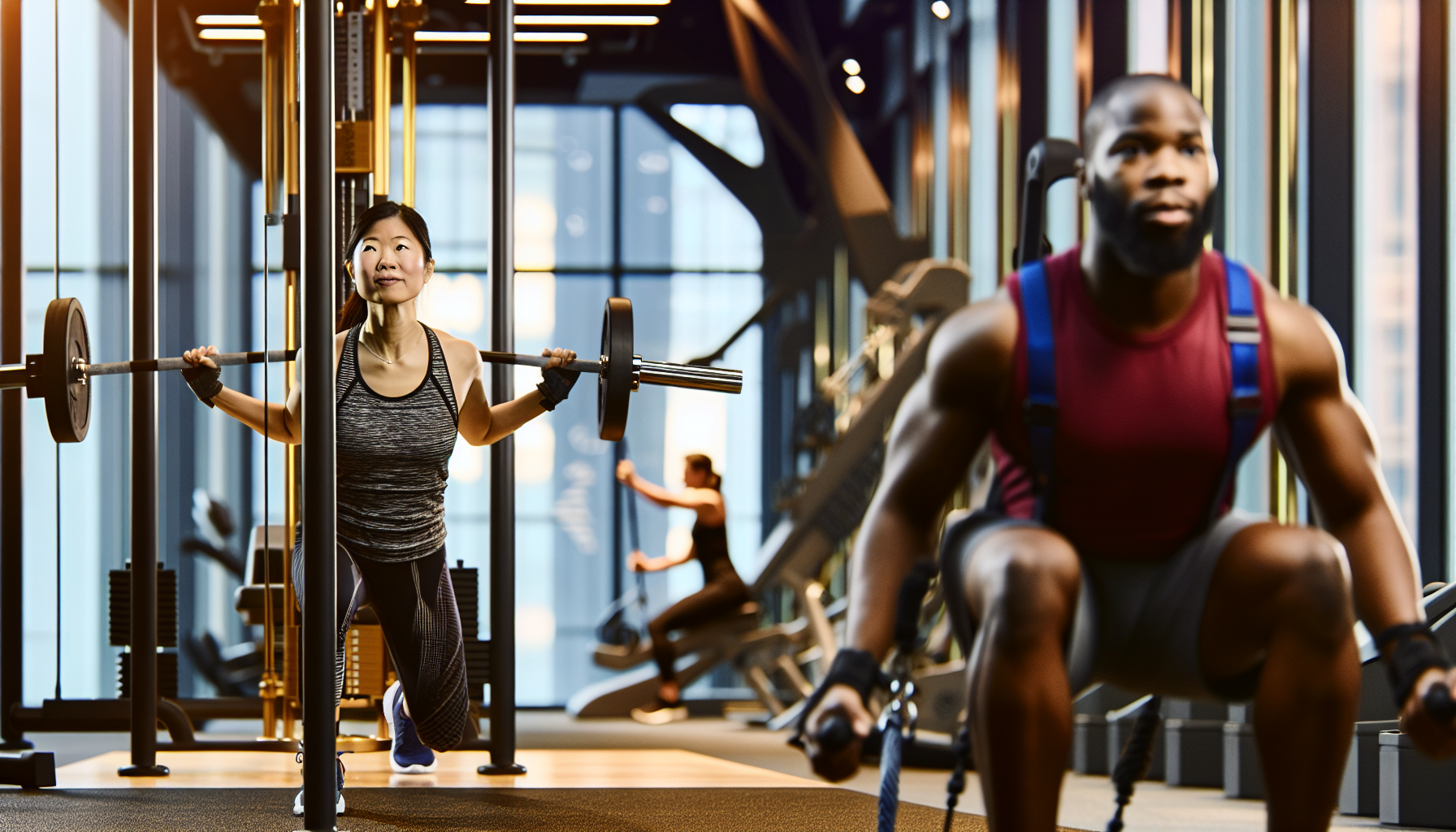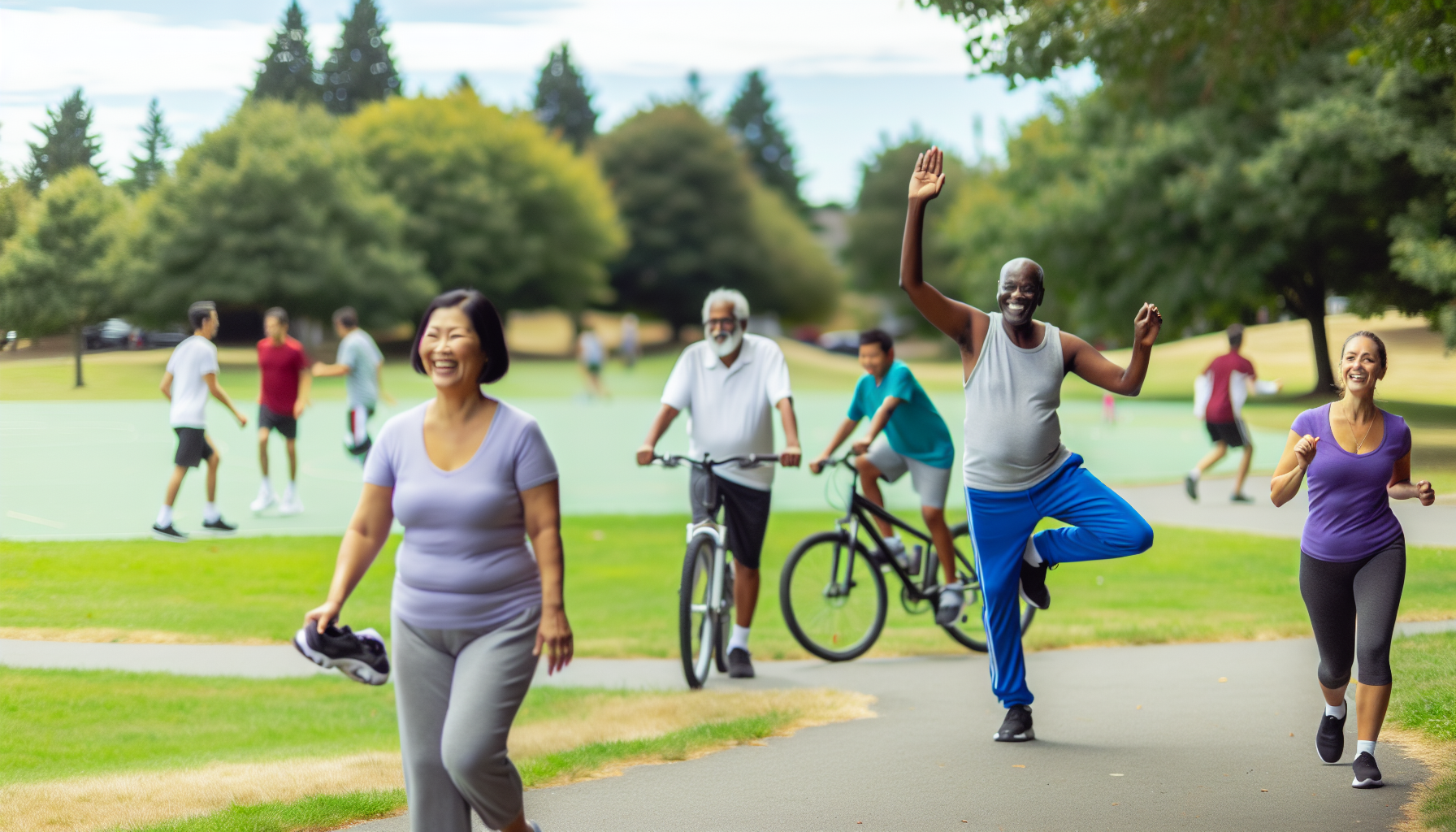Why is the importance of regular physical activity often emphasized? It’s simple: exercise strengthens your heart, controls weight, and boosts mental health. In this article, we dive straight into the tangible benefits of the importance of regular physical activity—clarifying how it fights chronic diseases and improves your day-to-day life without overwhelming medical jargon. Ready for a life with fewer health worries and more vitality? Keep reading to understand why movement matters.
Table of Contents
ToggleKey Takeaways
- Regular physical activity provides numerous health benefits, including reducing the risk of chronic diseases such as heart disease and diabetes, aiding in weight management, and improving mental health and cognitive function.
- Physical exercises are varied, ranging from aerobic and cardiovascular exercises to strength training and flexibility exercises, all contributing uniquely to overall health and should be integrated into regular fitness routines.
- A holistic approach to health that includes a balanced diet, proper hydration, restorative sleep, and regular physical activity is essential for optimal well-being. Technological advancements and community engagement can further support and encourage an active lifestyle.
Unlocking the Power of Movement

Adopting a physically active lifestyle opens up a vast array of health benefits. Consistent exercise acts as a powerful shield, safeguarding us from bodily illness and consequently reducing stress. Studies show that engaging in regular physical activity can lead to higher self-esteem and a sense of achievement by meeting exercise goals. Such accomplishments, no matter how small they may seem, contribute to our overall sense of self-worth.
The health benefits of regular physical activity go beyond just improving our physical fitness. Our mental well-being is also significantly influenced by our level of physical activity. Research suggests that even modest amounts of exercise can make a considerable difference in our mental health and well-being. So, the next time you’re feeling down, remember that engaging in physical activities like brisk walking or strength training can be a powerful mood booster.
The significant influence of regular physical activity on our health extends further. By preventing chronic conditions like heart attacks, diabetes, and depression, exercise contributes to stress reduction. Imagine a lifestyle where you’re not only physically fit but mentally resilient, where you navigate life’s challenges with the confidence of a seasoned sailor. That’s the power of consistent physical activity. It’s a journey to a healthier, happier you.
The Heart of the Matter: Cardiovascular Benefits
The core of regular exercise holds an abundance of benefits, particularly in preventing cardiovascular disease. Regular physical activity:
- Strengthens the heart and blood vessels
- Lowers cholesterol levels
- Reduces the risk of sudden heart attacks
- Mitigates many risk factors associated with heart disease
- Functions similarly to a beta blocker by slowing the heart rate and lowering blood pressure
- Increases high-density lipoprotein (HDL) and controls triglycerides
It is recommended to engage in 150 minutes a week of moderate physical activity to lower the risk of heart disease and high blood pressure.
By reducing stress hormones that can overburden the heart and enhancing the muscles’ efficiency in using oxygen from the blood, exercise minimizes the need for the heart to pump more blood to the muscles.
Weight Management Through Motion
The path to weight loss and maintenance need not be a tumultuous journey characterized by starvation and deprivation. Instead, it can be a rewarding path of consistent exercise and balanced eating. Regular and consistent exercise, exceeding basic health recommendations, is more likely to contribute effectively to long-term weight loss and weight maintenance. Exercise not only promotes weight loss in overweight individuals but also helps in reducing weight gain over time, which is vital for overall health.
Post-weight loss, higher activity levels have been linked with successful weight maintenance and less weight regain. So, the next time you step on the scale, remember the power of movement in your weight management journey.
Mental Clarity and Emotional Resilience
Physical activity extends beyond just setting personal records or attaining an athletic physique. It’s also about building mental clarity and emotional resilience. Exercise has a significant positive impact on mental health challenges like depression, anxiety, and ADHD. It releases endorphins, powerful chemicals in the brain that elevate mood and provide an energized spirit, contributing to reduced depression.
Regular aerobic exercise’s capacity to exhilarate and relax is a powerful counter to depression and a way to dissipate stress. Participation in regular physical activity can build resilience and enhance the ability to cope with mental or emotional challenges. So, the next time you lace up your running shoes, remember that you’re not just working on your body, you’re strengthening your mind.
Building Strength, Improving Life

Expanding past cardiovascular health, we venture into the realm of strength training. This form of physical activity, often associated with athletes and bodybuilders, holds immense benefits for everyone – from making daily tasks easier to managing pain in conditions like arthritis. Strength training can lead to an increased quality of life by strengthening muscles, ligaments, and tendons, thereby reducing the risk of injuries.
The benefits of strength training extend well beyond the gym. It can:
- Increase metabolism for more efficient calorie burn
- Decrease abdominal fat linked to chronic diseases
- Enhance physical appearance by fostering a leaner and more defined body
So, the next time you pick up those weights, remember that you’re not just building muscles, you’re sculpting a healthier and more resilient version of yourself.
Strength training isn’t exclusively for the youthful or athletic individuals. It’s an essential part of maintaining physical health and independence as we age. Regular strength training can:
- Lower the risk of falls by enhancing muscle strength and equilibrium
- Stimulate bone resilience, reducing the risk of osteoporosis, a common condition that can lead to mobility issues and increased fall risk
- Counter the loss of muscle mass and strength, enhancing mobility and prolonging independent living
Enhancing Muscle Strength for Daily Tasks
Have you found yourself grappling with heavy grocery bags or feeling weary after a day full of errands? If so, strength training can be your secret weapon. Muscle strengthening activities increase the ability to perform tasks like opening doors or lifting boxes without fatigue. Improved muscular strength and endurance lead to a reduced risk of injury during daily activities and can improve posture by strengthening the muscles that support the spine.
Exercises such as wall push-ups, chair squats, hip flexion exercises, and side leg raises can be done at home to improve upper body strength, lower body balance, and enhance stability.
Preserving Muscle Health in Older Adults
With advancing age, maintaining muscle health is paramount to sustaining mobility, independence, and holistic health. Sarcopenia, the loss of muscle mass and strength, can be countered through regular strength training. It supports an active lifestyle by increasing muscle strength, thereby aiding in the maintenance of mobility and independence.
For those with arthritis, strength training has been shown to significantly improve pain management and physical functioning. Even more impressively, strength training contributes to better brain health and may protect against age-related cognitive decline through its neuroprotective effects. So, strength training is not just about building muscles, it’s about building a healthier, more independent life.
The Spectrum of Physical Activities

The realm of physical activity is as varied as it is advantageous. Defined by the World Health Organization (WHO) as any bodily movement produced by skeletal muscles requiring energy expenditure, physical activity can take many forms, including:
- Brisk walking
- Running
- Cycling
- Swimming
- Dancing
- Yoga
- Pilates
- Strength training
With each type of exercise comes a unique set of benefits that cater to different aspects of our health, including targeting major muscle groups.
Aerobic exercises encompass activities like:
- Jumping rope
- Running
- Walking
- Swimming
- Stationary cycling
- Using elliptical machines
These exercises not only improve cardiovascular health but also contribute to weight management and mental well-being. Engaging in outdoor activities like hiking and cycling, as well as utilizing interactive games, provides diverse, enjoyable ways to engage in physical exercise for all age groups.
At the other extreme, strength training and flexibility exercises come into play. Strength training, as discussed earlier, is crucial for enhancing muscle strength and overall physical health. Flexibility and balance exercises, on the other hand, are essential for injury prevention and overall well-being. They involve activities that improve the range of motion around the joints and enhance body balance. By incorporating a variety of these physical activities into our routine, we can ensure a comprehensive approach to health and well-being.
Top Ten Fun and Effective Workouts for Teenagers to Build Healthy Habits
Aerobic Exercises: A Breath of Fresh Air
Often referred to as ‘cardio’, aerobic exercises are activities designed to elevate your breathing and heart rate. Examples of moderate aerobic exercises include brisk walking, biking, and swimming, while vigorous aerobic exercises can be running, swimming laps, and aerobic dancing. Swimming is particularly beneficial as a low-impact aerobic exercise, improving cardiovascular endurance and muscle tone while being suitable for individuals with limited mobility.
For achieving cardiovascular benefits, it’s crucial to maintain physical activity within the target heart rate zone, which differs based on age and fitness level. So, whether you prefer a brisk walk in the park or a high-energy Zumba class, aerobic exercises can keep your heart beating at its best.
Flexibility and Balance: Bend, Don’t Break
Despite strength and aerobic exercises frequently taking centre stage, flexibility and balance exercises hold an equally vital role in our fitness routine. Strength training enhances flexibility and improves joint range of motion, while balance exercises such as walking heel-to-toe and standing on one foot are simple yet effective techniques for preventing injuries. For older adults, activities like standing on one foot are particularly crucial for improving balance and cognitive health.
Yoga and tai chi are exemplary mind-body exercises that integrate physical movement with mental focus, enhancing flexibility, balance, and providing stress relief. So, remember to incorporate activities targeting flexibility and balance in your fitness routine, because it’s not just about the strength, it’s about the balance too.
Strength Training: Building Your Body’s Foundation
Strength training, commonly associated with bodybuilding, carries extensive benefits for all individuals. It increases muscle mass, strength, and endurance, and can reduce abdominal fat linked to chronic diseases like heart disease and type 2 diabetes. Different approaches to strength training include muscular hypertrophy for building muscle, training for muscular endurance, maximum strength training, and explosive power training to enhance athletic performance.
By increasing muscle mass, strength training boosts metabolism, which is more efficient than fat at burning calories even at rest, and also correlates with stronger, healthier bones. So, whether you’re using weight machines, free weights, or simply your body weight, remember that strength training is building your body’s foundation for a healthier future and may help in preventing metabolic syndrome.
Wellness Beyond the Gym

Although physical activity is a vital element in maintaining health and wellness, it only represents a single piece of the larger picture. To achieve optimal health, we need to take a holistic approach that includes:
- Nutrition
- Hydration
- Sleep
- Physical activity
Combining adequate nutrition with physical activity is crucial for providing the necessary energy for exercise, as well as supplying nutrients needed for recovery and repair of the body. Balanced intake of macronutrients including carbohydrates, proteins, and fats is essential to optimize performance and enhance recovery during and after physical activity.
Hydration is another crucial aspect of wellness. Proper hydration is critical for maintaining exercise performance and preventing adverse effects like altered metabolic function and cardiovascular strain. So, the next time you grab your gym bag, don’t forget to pack a water bottle along with your fitness gear.
Lastly, but no less crucial, is the role of restorative sleep in our journey towards wellness. Engaging in regular physical activity contributes to falling asleep faster, an overall improvement in sleep quality, and the ability to experience deeper sleep. So, while you’re working hard to stay active and eat well, don’t forget to give your body the rest it needs to recover and rejuvenate.
Fueling Growth: Essential Teen Nutrition for Lifelong Health
Nutritional Synergy with Physical Fitness
A balanced diet and consistent exercise are inseparable components in the pursuit of physical fitness and holistic health. Combining regular physical activity with a healthy diet is more effective for weight loss and prevention of heart disease than exercise alone. Some benefits of a healthy diet and exercise include:
- Weight loss
- Increased energy levels
- Improved cardiovascular health
- Reduced risk of chronic diseases
- Stronger muscles and bones
- Improved mental health
Antioxidant-rich foods, such as berries, aid in reducing oxidative stress and inflammation that can be triggered by exercise, thereby improving recovery times and exercise performance.
Implementing strategic nutrition timing by consuming specific nutrients before, during, and after physical activity can significantly improve performance and recovery, while also enhancing body composition. So, the next time you plan your workout, remember to also plan your meals to fuel your body right.
Restorative Sleep: The Unsung Hero of Recovery
Within the scope of health and wellness, sleep frequently fails to receive its due attention. Regular physical activity promotes improved sleep quality, which fundamentally supports the body’s recovery mechanisms like muscle repair and psychological well-being.
Here are some key points to consider:
- Strength training is associated with enhanced sleep quality.
- For all age groups, moderate-intensity physical activity is often more effective at improving sleep than high-intensity exercise.
- The timing of exercise, preferably in the morning or afternoon, can affect sleep quality.
- Consistent exercise is particularly beneficial in reducing sleep latency and nocturnal awakenings.
So, while you’re working hard in the gym, don’t forget to give your body the rest it needs to recover and wake up refreshed for another day of physical activity.
Stress Relief in Motion
Exercise extends beyond just building strength or shedding weight; it also serves as a potent stress reliever. Group fitness classes, such as cardio-kickboxing and Zumba, combine aerobic exercise with elements of dance and strength training, offering a powerful stress-relieving effect. Repetitive and rhythmic physical activities involving large muscle groups, like walking or jogging, can function as a form of ‘muscular meditation’, significantly diminishing stress levels.
Engaging in physical activity can act as an escape from daily stress and provide a space for either social engagement or solitude, contributing to effective stress management. So, the next time you’re feeling overwhelmed, remember that physical activity can be your pathway to tranquility.
Guidelines for a Physically Active Lifestyle

Sustaining a physically active lifestyle doesn’t necessitate running a marathon or bench pressing twice your body weight. It’s about integrating physical activity into your everyday life in a way that is enjoyable, sustainable, and beneficial to your health. Healthy adults should aim for at least 150 minutes of moderate aerobic activity or 75 minutes of vigorous activity weekly, according to the ‘Physical Activity Guidelines for Americans’. A well-rounded exercise regimen includes both aerobic exercises, like walking or cycling, and moderate strength training twice a week. Increasing physical activity by just 10 minutes a day can significantly reduce the risk of premature death among adults aged 40 and older.
Physical activity is beneficial for everyone, regardless of age, abilities, ethnicity, shape, or size. Special guidelines are available from WHO for groups such as children under 5 years, pregnant, and postpartum women to meet their unique health needs. One might wonder how much physical activity is needed; approximately 110,000 deaths per year could be prevented if US adults increased their moderate-to-vigorous physical activity. Despite these alarming statistics, in 2016, about 28% of adults worldwide did not meet the minimum exercise recommendations, emphasizing the global need for increased physical activity.
While striving for the recommended activity levels, individuals should aim to be as active as possible to reap some health benefits. Start with small, manageable goals, gradually building up to more intense and longer periods of physical activity. Whether it’s taking the stairs instead of the elevator, parking a little further away from the office, or taking a brisk walk during your lunch break, every step counts towards a healthier and more active you.
Starting Small: Simple Ways to Get Moving
Starting a fitness journey can be daunting, but remember, every great journey begins with a single step. Here are a few tips to help you get started on your path to physical fitness.
Set a specific time for daily physical activity and consider engaging with a friend or group for support. Exercise routines can begin with shorter sessions to help build the habit of physical activity. Regularize your exercise regimen by scheduling workouts when you have the most energy and making them a fixed part of your daily routine. Incorporate more physical activity into your daily routines by taking stairs instead of elevators or actively engaging in household chores.
Choose activities that you find fun and relaxing to foster a positive exercise experience. Always listen to your body when starting to exercise and take breaks if you experience any pain or discomfort to avoid injury.
Setting Achievable Goals: From Brisk Walk to Brisk Lifestyle
Establishing attainable goals is fundamental for sustained success in physical activity. Start with manageable goals, such as a brief run, and gradually increase the challenge to enhance ongoing motivation and improve the likelihood of maintaining an exercise routine. Fitness technology supports regular exercise adherence by incorporating behavior change techniques such as goal setting, feedback, rewards, and social engagement.
Cultivating regular exercise habits is essential for its sustainability, ensuring that physical activity remains an enduring part of one’s lifestyle. So, whether your goal is to run a marathon, lose weight, or simply stay active, remember to set realistic goals and celebrate every milestone along the way.
Innovations and Support Systems in Physical Activity
In this technological era, the fields of fitness and health have also witnessed notable advancements. Health wearable devices like pedometers and heart rate monitors, alongside mobile apps, enable real-time monitoring and motivation for increased participation in physical activities. Advancements in wearable technology have improved the detection of a range of physical activities, enabling more accurate tracking of exercises such as bench pressing or stair climbing. Systems such as the Personal Activity Location Measurement System combine accelerometer and GPS data to estimate physical activity energy expenditure and provide locational context.
The internet and technology have also ushered in a new era of community engagement in physical fitness. Online platforms like Stickk.com utilize monetary incentives to create contracts and promote behavioral changes toward more physical activity. Technologies are being adopted to inspire health and physical activity through novel means, such as:
- active video games
- fitness trackers
- virtual reality workouts
- online fitness challenges
- fitness apps
These platforms and technologies leverage the power of community input and online engagement to encourage individuals to stay active and lead healthier lives.
However, while these innovations offer numerous benefits, they also present challenges such as ensuring affordability and accessibility to all populations, and collecting long-term data. Despite these challenges, the future of fitness technology looks promising, offering innovative solutions to increase and promote physical activity across a wide range of populations and settings.
Tech Tools for Tracking Progress
The emergence of fitness technology has transformed our approach to monitoring progress and maintaining motivation on our fitness journey. From smartphone applications to wearable devices, these tech tools provide innovative solutions to increase and promote physical activity. There are over 40,000 health and fitness apps available, such as Map My Walk, Runkeeper, and My Fitness Pal, which are leveraged by more than half of smartphone users to track their physical activity.
Fitness trackers from brands like Fitbit, Garmin, and Xiaomi are popular for monitoring:
- daily steps
- heart rate
- sports activities
- sleep statistics
They provide accessible online data for goal tracking. So, whether you’re a fitness enthusiast or a beginner starting your journey, there’s a tech tool out there to help you stay on track and reach your fitness goals.
Community Engagement: Finding Your Fitness Tribe
Identifying a fitness tribe can render the journey towards a physically active lifestyle more enjoyable and enduring. Community programs and planning initiatives like ‘Designing and Building Healthy Places’ provide evidence-based strategies to develop environments that promote regular physical activity. Initiatives such as ‘Active People, Healthy Nation’ and ‘Health Equity Resources’ aim to collaboratively create active communities and address health equity by removing barriers to physical activity.
Engaging in group fitness activities, like sports and dance classes, creates social bonds and enhances overall wellness through a shared sense of enjoyment and commitment. So, find your tribe, stay active, and make your journey to fitness a fun and fulfilling one.
Summary
From enhancing cardiovascular health to building mental resilience, from strength training to holistic wellness, regular physical activity offers a plethora of benefits that extend beyond the gym. It’s about incorporating movement into our everyday lives in ways that are sustainable, enjoyable, and beneficial to our health. The journey to a physically active lifestyle is not a race, nor is it a competition. It’s a personal journey of growth, resilience, and self-discovery. So, embrace the power of movement, set achievable goals, find your fitness tribe, and make physical activity a non-negotiable part of your lifestyle. Because when it comes to your health and happiness, every step counts.
Frequently Asked Questions
What are 20 benefits of physical activity?
Regular physical activity can bring about numerous benefits for your overall well-being and health.
Why should we do physical exercise everyday?
Engaging in daily physical exercise can improve your overall health, reduce the risk of various diseases, strengthen muscles, and boost endurance, ultimately enhancing your quality of life. Regular physical activity also enhances brain health, helps manage weight, and improves the ability to perform daily tasks.
How does strength training aid in daily tasks?
Strength training aids in daily tasks by enhancing muscle strength and endurance, making activities such as opening doors or lifting boxes easier and reducing the risk of injury.
What types of exercises can help improve flexibility and balance?
Practicing yoga, tai chi, walking heel-to-toe, and standing on one foot are all exercises that can help improve flexibility and balance. These activities can significantly enhance your overall stability and range of motion.
How can nutrition augment the benefits of physical activity?
Nutrition can enhance the benefits of physical activity by supporting weight loss, reducing the risk of heart disease, and optimizing performance and recovery. A balanced intake of macronutrients such as carbohydrates, proteins, and fats is crucial for these benefits.
Share this post: on Twitter on Facebook on Google+







